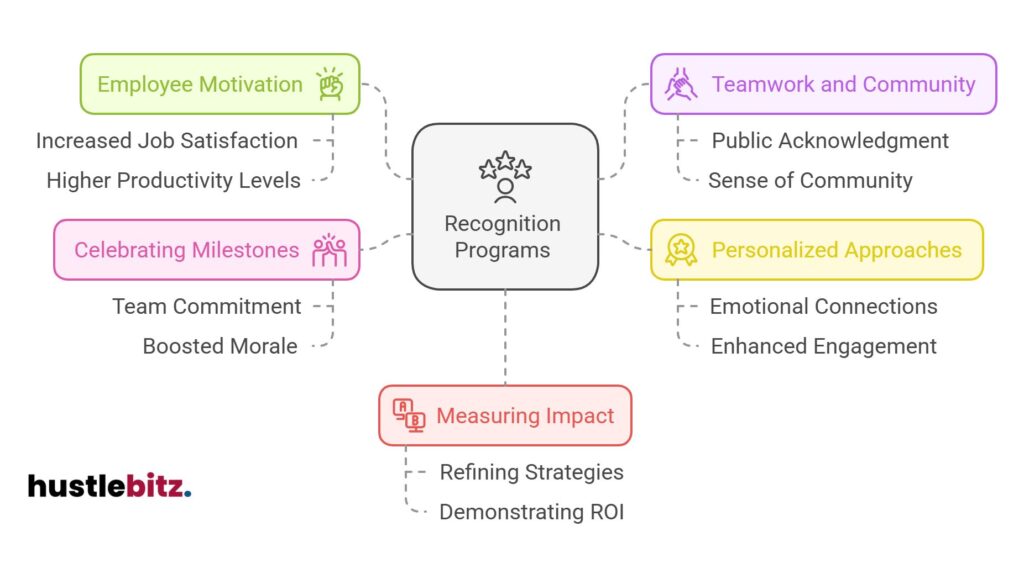Implementing effective employee recognition strategies is crucial for boosting productivity. Recognizing achievements fosters motivation and job satisfaction, enhancing overall workplace morale. Various programs, including monetary rewards, public acknowledgment, and informal shoutouts, cater to diverse employee preferences. Peer-to-peer recognition builds a collaborative culture, while celebrating milestones reinforces team cohesion. Personalized approaches ensure meaningful acknowledgment, making employees feel valued. Measuring the impact of recognition initiatives helps organizations refine their strategies to maximize results. By exploring the nuances of these practices, companies can unlock their full potential and enhance workplace performance in purposeful ways.
Key Takeaways
- Implementing recognition programs enhances employee motivation, leading to increased job satisfaction and productivity levels.
- Regular public acknowledgment fosters teamwork and a sense of community among employees.
- Personalized recognition approaches align rewards with individual preferences, enhancing emotional connections and engagement.
- Celebrating milestones and achievements reinforces commitment and boosts morale within teams.
- Measuring the impact of recognition initiatives provides insights to refine strategies and demonstrate ROI.

Importance of Employee Recognition

Employee recognition is essential for fostering motivation and engagement, as it directly influences job satisfaction and overall organizational performance. When employees feel appreciated for their contributions, their motivation levels significantly increase, leading to higher employee satisfaction.
A positive workplace culture emerges when recognition is integrated into daily practices, promoting an environment where individuals feel valued and encouraged to collaborate as a team.
The frequency of recognition plays a pivotal role in enhancing retention rates. Organizations that prioritize consistent acknowledgment of employee efforts experience lower turnover, as individuals are more likely to remain with a company that appreciates their hard work.
Additionally, effective performance feedback, coupled with recognition, reinforces desired behaviors and drives continuous improvement within teams.
Leadership involvement is crucial in establishing a strong recognition framework. When leaders actively participate in recognizing their team members, it not only boosts morale but also sets a standard for recognition throughout the organization.
While some may perceive recognition costs as a burden, the organizational benefits far outweigh these expenses. Investing in recognition strategies leads to improved employee engagement, productivity, and ultimately, enhanced organizational performance.
Types of Recognition Programs
Various recognition programs can be implemented to celebrate employee achievements and enhance motivation within the workplace. These programs can take on various forms, each tailored to meet the unique needs of the organization and its employees.
Monetary rewards serve as a powerful incentive, motivating employees to excel in their roles. Public acknowledgment of accomplishments allows employees to feel valued in front of their peers, fostering a sense of community. Award ceremonies can formalize this recognition, providing a platform to honor outstanding contributions in a celebratory atmosphere.
Informal shoutouts during team meetings can also be effective, offering immediate recognition for both small and significant achievements. Team competitions can further engage employees, encouraging collaboration and friendly rivalry while celebrating collective successes.
Leadership endorsements are crucial as they reinforce the importance of recognition from those in power, making it more impactful. Programs like ’employee of the month’ highlight consistent performance and commitment, while skill showcases provide opportunities for employees to demonstrate their talents, promoting professional growth.
Moreover, feedback loops are essential in recognizing employee contributions regularly, creating a culture of ongoing appreciation. The advent of recognition technology allows organizations to streamline their recognition efforts, making it easier to track and celebrate achievements in real time.
Peer-to-Peer Recognition

Peer-to-peer recognition fosters a collaborative environment where colleagues can acknowledge and celebrate each other’s contributions, enhancing overall team morale and cohesion.
This form of recognition is crucial for culture building, as it encourages a sense of belonging and reinforces the values of teamwork and support within the organization.
By implementing peer feedback mechanisms, companies can promote informal recognition that highlights individual efforts and achievements.
Utilizing recognition tools and platforms can effectively streamline this process. These systems enable employees to share their appreciation for one another, making recognition not just a formal event, but a daily practice that enhances employee engagement.
Key strategies for promoting peer-to-peer recognition include:
- Organizing appreciation events that encourage team bonding and social recognition.
- Leveraging recognition platforms to facilitate easy exchange of feedback and acknowledgment among colleagues.
- Encouraging gratitude practices that empower employees to express their thanks in meaningful ways.
- Incorporating regular check-ins where employees can share positive experiences and recognize each other’s contributions.
Celebrating Milestones and Achievements

Celebrating milestones and achievements is essential for recognizing individual and team contributions, fostering motivation, and reinforcing a culture of success within the organization. Milestone celebrations not only acknowledge significant events but also provide opportunities for employees to reflect on their hard work and dedication. Recognition events that highlight personal milestones, such as work anniversaries or career achievements, create a sense of belonging and loyalty among employees.
Achievement awards serve as tangible tokens of appreciation, showcasing the organization’s commitment to recognizing excellence. These awards can be presented during team shout outs, where colleagues publicly acknowledge each other’s efforts, thus promoting a supportive work environment. Moreover, goal celebrations upon project completions can invigorate teams, encouraging them to pursue future objectives with enthusiasm.
Sharing success stories during these events amplifies the impact of recognition. By highlighting specific achievements and the individuals behind them, organizations can inspire others to strive for similar successes. Additionally, incorporating anniversary recognition into the workplace culture fosters a sense of continuity and pride among employees, reinforcing their connection to the organization.
Ultimately, celebrating milestones and achievements is not merely a formality; it is a vital strategy for enhancing employee engagement. When employees feel valued for their contributions, they are more likely to remain motivated, productive, and committed to the organization’s goals. By prioritizing these recognition practices, organizations can cultivate an environment where success is celebrated, and individuals are inspired to reach new heights.
Personalized Recognition Approaches
Consistently implementing personalized recognition approaches can significantly enhance employee motivation and engagement by catering to individual preferences and contributions. This tailored strategy acknowledges that not all employees respond similarly to recognition, thus fostering a more inclusive workplace culture. Utilizing recognition diversity allows organizations to adapt their methods to meet employee preferences, ensuring that recognition is not only effective but also culturally relevant.
To effectively personalize recognition, organizations can adopt the following strategies:
- Custom rewards that align with individual interests, such as gift cards or experiences.
- Recognition timing that coincides with project completions or significant milestones, maximizing impact.
- Feedback loops that solicit employee input on preferred recognition methods, ensuring ongoing improvement.
- Meaningful gestures that reflect an understanding of employees’ contributions, enhancing the emotional connection.
Employing recognition technology can facilitate these individualized experiences, allowing managers to track employee preferences and tailor acknowledgment accordingly.
Moreover, the scalability of personalized recognition approaches ensures that even large organizations can implement effective strategies without losing the personal touch.
By focusing on recognition that resonates with employees, companies can create an environment where contributions are genuinely valued, leading to increased motivation and productivity.
Ultimately, a commitment to personalized recognition fosters a culture of appreciation that not only enhances individual performance but also strengthens team cohesion and organizational loyalty.
Measuring the Impact of Recognition

Measuring the impact of recognition is essential for organizations seeking to understand its effectiveness in boosting employee motivation and overall performance. To achieve this, companies must establish clear recognition metrics that align with their strategic goals. By tracking these metrics, organizations can gain insights into employee engagement levels, retention rates, and overall job satisfaction.
One effective method for measuring the impact of recognition is through regular employee surveys. The effectiveness of these surveys hinges on their design and frequency, ensuring that feedback is both relevant and timely. Analyzing satisfaction scores in relation to recognition initiatives can reveal productivity correlations, highlighting how acknowledgment affects performance outcomes.
Performance tracking is another critical aspect of measuring recognition impact. By monitoring changes in productivity and engagement before and after implementing recognition programs, organizations can assess their effectiveness. Additionally, recognizing trends over time allows companies to refine their strategies, ensuring they remain aligned with employee preferences and organizational goals.
To fully understand the return on investment (ROI) of recognition initiatives, organizations should conduct comprehensive ROI analysis. This involves quantifying the financial benefits derived from increased productivity and reduced turnover against the costs of recognition programs.
Final Thoughts
Employee recognition is a vital strategy for enhancing productivity and morale in the workplace. By implementing diverse recognition programs—such as monetary rewards, public acknowledgment, and peer-to-peer recognition—organizations can effectively boost motivation and job satisfaction. Personalized recognition approaches and celebrating milestones further reinforce a positive work environment and strengthen team cohesion. Measuring the impact of these initiatives through regular feedback and performance tracking helps refine strategies and demonstrate their value. Overall, a thoughtful approach to recognition not only acknowledges individual contributions but also drives collective success, leading to improved organizational performance and employee engagement.




